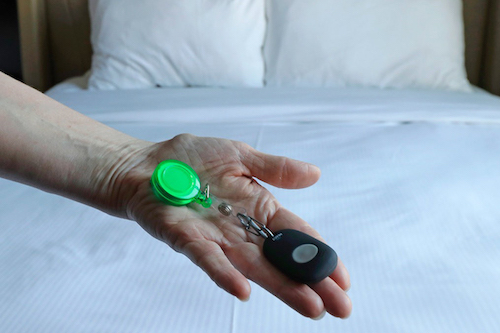
The pandemic has shifted the timetable for the adoption of worker safety technology, but now the clock is ticking; There are quick, easy, and effective ways to comply with AHLA’s 5-Star Promise and state legislation to protect hotel workers with confidence
By John Stachowiak
Hotel workers deserve to have the confidence that they are operating in a safe environment. Providing safety and security to hotel staff is getting even more difficult with fewer workers on property, making it even more important to have a plan in place in case of an emergency. Fortunately, technology is available to help protect hotel workers regardless of who is on property — and depending on your hotel’s location, it may become mandatory soon.
In 2018, the American Hotel & Lodging Association was joined by several hotel leaders in signing the “5-Star Promise,” a voluntary commitment to bolster policies, resources, and training to improve employee safety, including an investment in worker safety devices. This commitment was originally scheduled to go into effect by the end of 2020, but the deadline has been extended considering the COVID-19 pandemic.
Now, hotels that have committed to the 5-Star Promise are expected to fulfill their commitment by the end of 2022, and the requirements are beginning to spill out into other cities and states that have chosen to pass their own independent safety mandates. Illinois passed a statewide act requiring employee safety buttons in January 2020, while hotels in Washington State were expected to adopt this technology by the end of 2021. Other cities such as Chicago, Sacramento, and Miami Beach have followed through with their own ordinances and requirements for installing safety buttons.
These new mandates are becoming more common each year in major cities across the U.S., and pressure may force national requirements in time. For these reasons, and to protect their workers, hotels should prepare to adopt a tech solution for employee safety.
Protecting Yourself
The “how” behind addressing worker safety has been a concern in hospitality for many years. Hotel workers are not assets to be tracked and micromanaged by an invisible software; they should instead be empowered by technology to protect themselves in the event of a crisis. As a result, the industry has embraced safety buttons for their ability to give workers a way to always protect themselves.

Hotels must demonstrate the value their employees represent by always ensuring their protection. The reason panic button technology works so well in hospitality is that it provides worker protection and oversight without infringing on their personal space. These buttons enable hotel workers to provide the service and high-level interactions that make hotels so successful with the knowledge that support can arrive at a moment’s notice. Workers take note when employers act and provide self-governance over safety sends a positive message.
Small Barriers
Hotels are using the rebuilding period brought on by the pandemic to invest in massive infrastructure shifts, changing the way their hotels handle check-in, manage operations, and interact with guests. An investment in worker safety buttons is nowhere near as significant as these massive shifts and are necessary to fulfill safety obligations.
To deploy reliable, effective safety buttons across your hotel requires the installation of location beacons able to relay information from individual buttons to a centralized system. From there, the most important element in a successful deployment of employee safety technology is a consistent, fast internet connection and cloud-based hosting in the event of a network outage. The best way to fulfill these obligations is for hotels to meet with technology partners to ensure their properties have taken the necessary steps to support safety technology.
Operating in the industry right now is extremely strenuous and adding a new process onto that can seem like an insurmountable challenge. However, implementing safety buttons does not require infrastructure, time, or a massive shift to IT. An investment into worker safety pays more than revenue, it can ease the minds of operators.

Technology is only one part of a comprehensive safety plan, which is substantiated by training for what to do in the event of a crisis and ongoing reinforcement. The AH&LA’s 5-Star Promise additionally mandates anti-sexual harassment policies, education, and training for employees to help spot and report instances of sexual harassment, and partnerships with national and local organizations to help promote worker safety.
The 5-Star Promise was signed by the hotel industry four years ago, and since then strides in the sophistication and affordability of worker safety technology have made them a natural part of operating in the industry. Addressing this issue has become even more critical as staff sizes shrink and worker accountability increases.
The pandemic has shifted the timetable for the adoption of worker safety technology, but now the clock is ticking. The AH&LA is unlikely to release a second extension amid an ongoing labor crisis, and hotel workers need the reassurance that their leaders are watching out for them. Fortunately, there are many quick, easy, and effective ways to comply with the 5-Star Promise and protect hotel workers with confidence. The tools are here, and they are saving lives.

